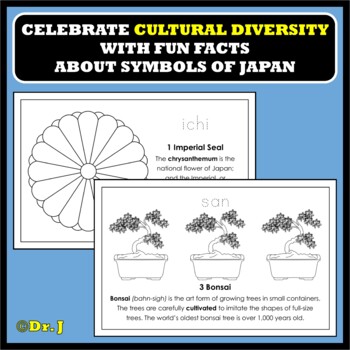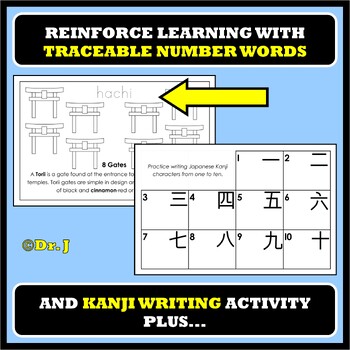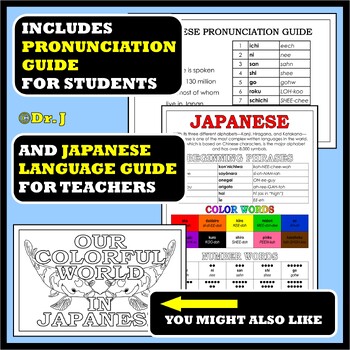JAPAN: Learn to Count in Japanese
- Zip
What educators are saying
Also included in
- Take an in-depth look at the symbols, language, geography, and traditions of Japan—at a savings of 25%—with the books, activities, and poster in the Exploring the Culture of Japan SUPER-Bundle. Book Resources Included:Snapshots of Japan introduces the location, national flag, cultural symbols, and lPrice $7.75Original Price $10.50Save $2.75
Description
Enrich your study of Japan with this engaging book that uses national and cultural symbols to teach Japanese number words from 1-10. LEARN TO COUNT IN JAPANESE includes the following features:
- fun facts about national and cultural symbols,
- traceable number words to boost retention,
- realistic illustrations to engage students,
- phonetic pronunciation guide for students,
- Kanji writing activity,
- teacher's language guide highlighting common phrases, color names, and number words.
Japanese Number Words: (phonetic pronunciation included)
1-ichi, 2-ni, 3-san, 4-shi, 5-go, 6-roku, 7-schichi, 8-hachi, 9-kyuu, 10-juu
Additional Vocabulary Words and Phrases:
archipelago, blossom, bonsai, chrysanthemum, cultivate, fictional, Hiragana, Kabuki, Kanji, Katakana, koi, legend, matcha, origami, passport, precise, prosperity, ritual, sakuru, sensu, sumo, Torii, uchiwa
Targeted Skills:
- Learning number words in Japanese
- Writing number words in Japanese Kanji characters
- Promoting respect and appreciation for cultural differences
- Identifying national and cultural symbols of Japan
- Critical thinking skills of comparing and contrasting
- Reading fluency and comprehension
- Building content-area literacy in social studies
Sample Pages: Please see the preview for sample pages from the book.
Image Credits: The illustrations in this book are my own original drawings (©Dr.J).
Technical Info: The book and language guide are in PDF format, combined into a single zip file.
_________________________________________________________________
Bundle and Save 25%: This book is included in the Exploring the Culture of Japan Bundle, which also contains the introductory book, Snapshots of Japan, a mini-coloring book of Japanese color names, five cross-curricular activities, and a colorful Symbols of Japan poster.
_________________________________________________________________
RELATED RESOURCES:
- Discovering JAPAN Activity Pack
- Our Colorful World in JAPANESE
- Snapshots of JAPAN
- Let’s Explore the Continent of ASIA POWERPOINT
- TASTE THE WORLD! International Recipes for Jr. Chefs
- The SEVEN CONTINENTS Activity Book
ADDITIONAL BOOKS IN THE LEARN TO COUNT SERIES:
- Learn to Count in ARABIC (Egypt)
- Learn to Count in ARABIC (Morocco)
- Learn to Count in ARABIC (Saudi Arabia)
- Learn to Count in CHEROKEE (Native American language)
- Learn to Count in CHINESE (China)
- Learn to Count in CHIPPEWA (Native American language)
- Learn to Count in DUTCH (The Netherlands)
- Learn to Count in FILIPINO (The Philippines)
- Learn to Count in FRENCH (France)
- Learn to Count in GERMAN (Germany)
- Learn to Count in GREEK (Greece)
- Learn to Count in HAUSA (Nigeria)
- Learn to Count in HEBREW (Israel)
- Learn to Count in HINDI (India)
- Learn to Count in ITALIAN (Italy)
- Learn to Count in LAKOTA SIOUX (Native American language)
- Learn to Count in NAVAJO (Native American language)
- Learn to Count in NORWEGIAN (Norway)
- Learn to Count in PORTUGUESE (Brazil)
- Learn to Count in RUSSIAN (Russia)
- Learn to Count in SPANISH (Colombia)
- Learn to Count in SPANISH (Mexico)
- Learn to Count in SPANISH (Spain)
- Learn to Count in SWAHILI (Kenya)
- Learn to Count in SWAHILI (Tanzania)
- Learn to Count in THAI (Thailand)
- Learn to Count in TWI (Ghana)
- Learn to Count in VIETNAMESE (Vietnam)
CLICK HERE to view all of my resources for languages around the world, including the Our Colorful World series of mini coloring books.
_________________________________________________________________
Connect with Let’s Get Real
Visit My Store: Click here to view more than 450 K-5 resources for building content-area and multicultural literacy. Look for the category list on the left side of the home page to find a specific science or social studies topic. Be sure to click on the GREEN STAR to receive my newsletter with Follower Freebies and updates on new resources.
Pinterest: Click here to check out the Let’s Get Real Pinterest boards for more ways to enrich your teaching themes.
_________________________________________________________________
Customer FAQs
What kinds of resources does Let’s Get Real offer?
All of my K-5 books, printables, posters, and games focus on content-area literacy—building the specialized vocabulary of science and social studies—because having an extensive vocabulary is not only a top predictor of reading success, it also has a huge impact on overall school success and standardized testing scores. My science materials target topics and standards outlined in the NGSS and TEKS. In social studies, I concentrate on multicultural literacy, providing resources that develop a knowledge of and appreciation for the diverse cultures in our global society.
How can I see what you offer or know when you’ve added new materials?
Click on the star to the right of this description (under my pic) OR click on my store link (above), then click on the star at the top of the page to follow Let’s Get Real. You’ll be the first to know about new materials, sales, and freebies. To view the resources by science/social studies topics, look to the left on the store page, under the heading Custom Categories.
What are TPT credits and how do I get them?
Every time you provide feedback for a purchase, TPT gives you 1 credit for each dollar you’ve spent. After you’ve used (and hopefully loved!) a resource, hover on your picture at the top of the page and open the “My Account” tab. Click on your “My Purchases” category. You should see a list of your purchases with a “Provide Feedback” button for each one. Just click the button and you’ll be taken to a page where you can rate the product and leave a comment for me. You can apply the credits you earn to any future purchases and I always appreciate your positive feedback.
What do I do if I have a question about or problem with a resource?
You can always contact me through the product Q & A tab, located at the bottom of the product description.
_________________________________________________________________
Terms of Use
Please “share the love” by telling others how much you like Let’s Get Real products; but please don’t share the copyright. Each Let’s Get Real resource—including graphics and illustrations—is copyrighted by Dr. J/Teaching Texas LLC and may not be redistributed, sold, or placed on the internet. This resource is for one teacher-use only. Thank you so much for your support!






